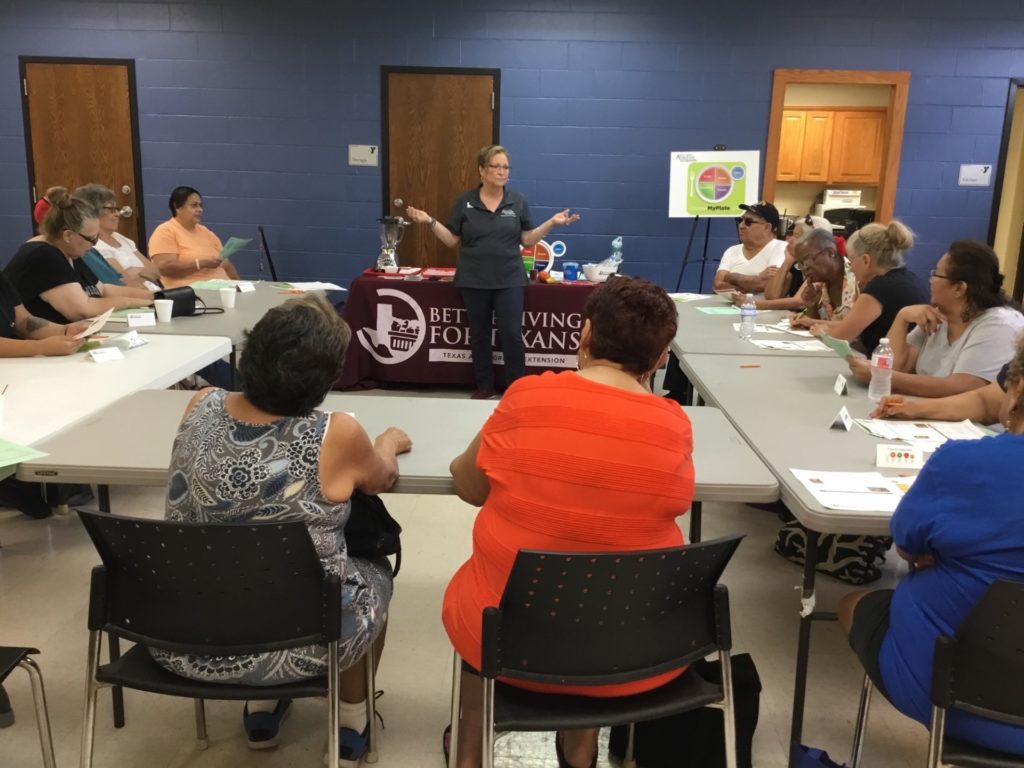Better Living for Texans program supports low-income senior health, wellness
Programs address nutrition, physical activity, more – often in a fun way
As people age, nutrition and physical activity are even more important to their overall health. Texas A&M AgriLife Extension Service has a special interest in providing senior nutrition education and wellness outreach.

The U.S. Census Bureau indicates that individuals 85 and up are the nation’s fastest-growing age group by percentage. Additionally, four in five older adults will have at least one chronic condition or illness during this time in their life.
“Healthy eating habits are important at any age – including those who are aging, often defined as 65 years of age and older,” said Jenna Anding, Ph.D., AgriLife Extension nutrition specialist in the Department of Nutrition and principal investigator for the Better Living for Texans SNAP-Ed program, Bryan-College Station. “Protein, vitamin B12, vitamin D, calcium and dietary fiber are just some of the nutrients that are important as we age.”
Better Living for Texans and Be Well, Live Well program
AgriLife Extension’s Better Living for Texans, BLT, program offers a variety of research-based, nutrition education programs to Texans in more than 210 of the state’s counties. Established in 1994, BLT is a cooperative effort of AgriLife Extension, the Texas Health and Human Services Commission and U.S. Department of Agriculture’s Food and Nutrition Service
“The BLT program helps people learn to make healthy food choices, become more physically active, save money at the grocery store and adopt better food safety habits,” Anding said. “The aim of the program is to help low-income Texans of all ages increase their fruit and vegetable consumption, become more physically active, stretch their monthly food dollars and learn how to prepare quick, nutritious meals.”
“An important part of BLT programming is the ‘Be Well, Live Well’ program designed specifically for older adults,” she said.
Be Well, Live Well is a five-session series focused on improving the diets and physical activity habits of adults 50 years of age and older. The program sessions are:
— Be Independent, Eat Well. Addresses what nutrients seniors require more of as they age, and which nutrients help support cognition and overall wellness.
— Be Able, Read the Label. Demonstrates how to properly read food nutrition labels so seniors can understand what nutrients various foods provide so they can maintain a healthy eating plan.
— Be Safe, Eat Safe. Provides information on how to keep food safe during shopping and while transporting, checking expiration dates on foods and safe storage practices.
— Be Creative, Plan Meals. Helps seniors with recipes and meal planning for making nutritious meals for individuals and small households.
— Be Fit, Move More. Explains the benefits of physical activity for seniors and shows how to integrate exercise into daily routines and activities.
According to Renda Nelson, Better Living for Texans state program director, Bryan-College Station, about one in every seven Texas households lives in poverty.
“Research shows individuals who live in poverty have dietary intakes deficient in the consumption of fruits and vegetables, whole grains, dairy products and lean meat,” Nelson said. “Dietary quality has been linked to four of the 10 leading causes of death, including heart disease, cancer, stroke and diabetes.”
Nelson also noted many low-income families are food insecure, meaning that the availability of nutritionally adequate, safe food is limited or uncertain.
“We try to design our programs in a manner that will resonate with a senior audience,” Nelson said.
She also noted that “Texas’ elder population is projected to reach nearly 5.5 million by 2030.
“Given what we know about the important role that healthy nutrition plays in the prevention of deadly and costly chronic diseases, educating seniors on nutrition and wellness will remain a high priority for AgriLife Extension,” Nelson said.
She said hundreds of thousands of low-income Texans, including seniors, benefit from the Better Living for Texans programming every year.
Senior nutrition education made fun
“We present several senior nutrition programs throughout the community every year, often in collaboration with other agencies or organizations supporting senior health and wellness,” said Mary Masterson, BLT agent for Bexar County. “Whenever possible, we try to make them fun and interesting for seniors.”
She said some examples of entertaining senior nutrition outreach in that county included a salsa-making program with a Cinco De Mayo theme and “nutrition bingo” programs for seniors.

“For the nutrition bingo programs, we used bingo cards with images of foods from the different food groups displayed in their recommended serving portions,” Masterson said.
She said senior nutrition outreach programs place an emphasis on keeping a healthful weight, making better dietary decisions, locating food resources and maintaining good food safety practices.
Masterson said they also do a Walk-N-Talk offshoot of AgriLife Extension’s Walk Across Texas! program, which challenges people to engage in physical activity by walking the equivalent of the length of Texas — about 832 miles — over an eight-week period.
“We walk with the seniors and talk about nutrition topics as they participate in the Walk Across Texas! program and get some exercise,” she said.
Kristina Brown, BLT agent in Harris County, sometimes incorporates a taste-testing activity in her senior health and wellness outreach.
“In this activity, I provide participants with samples of fresh fruits and vegetables along with a worksheet so they can ‘rate’ what they are tasting while also incorporating their other senses,” she said. “It’s a fun approach to mindful eating and also a way to encourage seniors to consider eating a wider variety of produce.”





